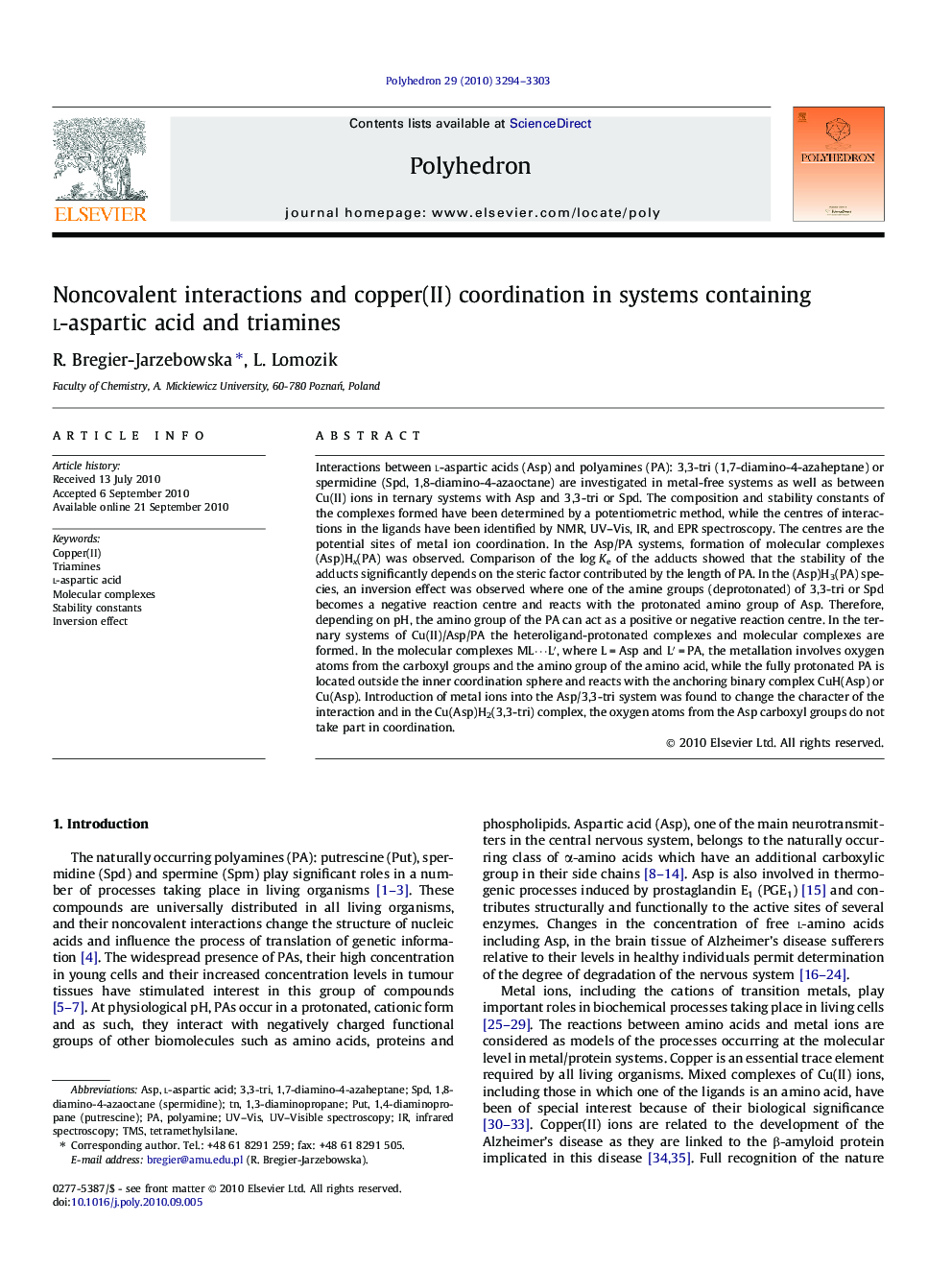| کد مقاله | کد نشریه | سال انتشار | مقاله انگلیسی | نسخه تمام متن |
|---|---|---|---|---|
| 1338698 | 979676 | 2010 | 10 صفحه PDF | دانلود رایگان |

Interactions between l-aspartic acids (Asp) and polyamines (PA): 3,3-tri (1,7-diamino-4-azaheptane) or spermidine (Spd, 1,8-diamino-4-azaoctane) are investigated in metal-free systems as well as between Cu(II) ions in ternary systems with Asp and 3,3-tri or Spd. The composition and stability constants of the complexes formed have been determined by a potentiometric method, while the centres of interactions in the ligands have been identified by NMR, UV–Vis, IR, and EPR spectroscopy. The centres are the potential sites of metal ion coordination. In the Asp/PA systems, formation of molecular complexes (Asp)Hx(PA) was observed. Comparison of the log Ke of the adducts showed that the stability of the adducts significantly depends on the steric factor contributed by the length of PA. In the (Asp)H3(PA) species, an inversion effect was observed where one of the amine groups (deprotonated) of 3,3-tri or Spd becomes a negative reaction centre and reacts with the protonated amino group of Asp. Therefore, depending on pH, the amino group of the PA can act as a positive or negative reaction centre. In the ternary systems of Cu(II)/Asp/PA the heteroligand-protonated complexes and molecular complexes are formed. In the molecular complexes ML⋯L′, where L = Asp and L′ = PA, the metallation involves oxygen atoms from the carboxyl groups and the amino group of the amino acid, while the fully protonated PA is located outside the inner coordination sphere and reacts with the anchoring binary complex CuH(Asp) or Cu(Asp). Introduction of metal ions into the Asp/3,3-tri system was found to change the character of the interaction and in the Cu(Asp)H2(3,3-tri) complex, the oxygen atoms from the Asp carboxyl groups do not take part in coordination.
Interactions between l-aspartic acid (Asp) and polyamines (PA): 3,3-tri or spermidine (Spd) in metal-free systems and in the presence of Cu(II) are investigated. In the molecular complexes of Asp with 3,3-tri and Spd the interaction centres are the oxygen atoms of carboxyl groups and the nitrogen atom from the amino group of aspartic acid as well as the amino groups of the polyamine. These centres are the potential sites of metal ion coordination. The length of the PA chain is an important factor influencing the formation of the adduct. Spd has a greater ability to form stable molecular complexes than its analogue 3,3-tri. An inversion in interaction was found, both in (Asp)H3(3,3-tri) as well as in (Asp)H3(Spd) adducts. The amino groups of the polyamine could act either as positive or negative centres of interaction, depending on the pH because the interaction characteristics depend on the degree of protonation. In the ternary systems with Cu(II) ions, the formation of heteroligand protonated complexes Cu(Asp)Hx(PA) and molecular complexes of the ML⋯L′ type was observed (L = Asp, L′ = PA). In these species, the fully protonated PA (with the donor centres blocked for metallation) is in the outer coordination sphere and is involved in noncovalent interactions with binary anchoring species Cu(H)x(Asp). The presence of metal ions changes the characteristics of the interactions relative to the interactions in the metal-free systems. For example, introduction of Cu(II) ions into the system Asp/3,3-tri results in disappearance of the noncovalent interactions in the (Asp)H2(3,3-tri) species. In the Cu(Asp)H2(3,3-tri) complex, only one amino group from the PA and the amino group of Asp coordinate to the metal ion, while with increasing pH, the carboxyl groups from Asp also become involved in the metallation.Figure optionsDownload as PowerPoint slide
Journal: Polyhedron - Volume 29, Issue 18, 7 December 2010, Pages 3294–3303